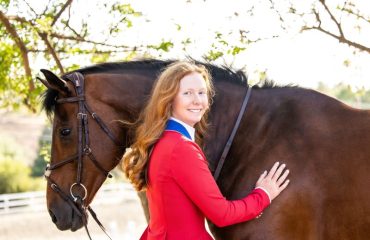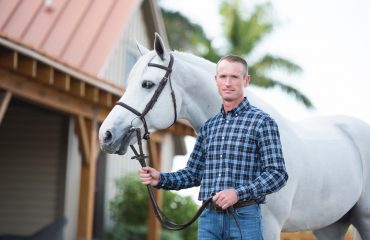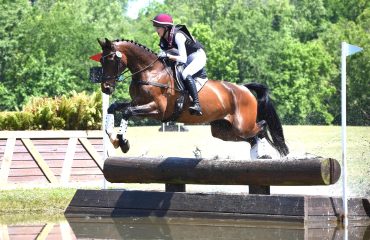Dressage Column
By George Williams
As a working student in the mid-70s for a well-known trainer in New Jersey, I was quite often told that it takes three lifetimes to learn how to ride and train a dressage horse. After 68 years since I first sat in a saddle (and never missing a year, nor barely even a month since), I feel like I’m just starting that third lifetime.
Aside from my age, this is primarily due to how I’m enjoying riding my own horse, Sir Velo. With a little more than six decades of experience in riding, teaching, training and coaching behind me, I find that when I’m riding my own horse, I enjoy it more than ever.
I refer to Sir Velo as my own horse, but really he’s a family horse who, as of this writing, has been a part of our family for 14 of his 17 years. Our actual ownership of him has only been for the last five years. He has a lovely but quirky character. Both my daughter and I have competed him at Grand Prix and, to be totally honest, she did it more successfully than I.
As a 5-year-old child, as I was galloping around our rocky New Hampshire family farm with my arms and legs flying every which way, our dressage aficionado farrier told my very embarrassed mother, “Don’t worry, the finesse will come later.” With the help of Pony Club, dressage instruction and hours of practice, it did improve some. Perhaps those years could qualify as my first “lifetime.” After finishing school, I dedicated my life to horses, first as a working student, then as an established professional and ultimately as an international competitor. By that point, I like to think there was finesse.
Although I still ride horses that I have in training and sometimes sit on students’ horses, it’s when I sit on my own horse that I feel like a recreational rider. I mean this in the very positive sense: I do it purely for my own enjoyment. I have nothing to prove and in a funny way, this makes me feel more open to learning. While it certainly can get harder to maintain the elegance of a younger rider, there are some benefits to age and a little wisdom.
As I’m not concerned about competing, there is far less pressure when setting my daily goals while riding my own horse. Don’t get me wrong—I still work on parts of the Grand Prix and Grand Prix Special tests. But I can approach those things in a way that allows me to play. For instance, one day I decided to play simply with the tempo of the collected canter. I had the help of a wonderful little gadget called Equestic to measure the beats per minute to see if I was able to indeed achieve what I set out to do. My previous rides had often shown that, while at times the tempo would increase to match other Grand Prix horses of his age and size, he didn’t always sustain it. That day I then compared the reading to not only my other rides, but I could also compare it to the average of his Grand Prix peers. Of course, I then had to consider how he felt in the connection, through his back, his balance and his ability to perform the appropriate movements in that tempo. It’s fun, with a sport that has been around for centuries, to watch new technological developments and apply them to our daily riding.
Each Grand Prix horse has at least one movement or combination that is more difficult than others. For my horse, the turn at K in the passage to a transition to piaffe at D from the Grand Prix test has always been tricky. In playing with it and with exercises that I thought could help, I discovered that under that kind of directive, the connection from inside leg to outside rein was yielded just enough to make it difficult to do the piaffe transition. So, improving that is now a goal.
What’s still amazing to me after so many years is how the basics, including the training scale (aka pyramid of training), are so crucial and how for a truly successful Grand Prix they must be established to the 10th degree. As we go through our different lives, our understanding of the level of competency required and true meaning of the simple words rhythm, relaxation, contact, impulsion, straightness and collection constantly increases—as does the finesse! To be sure, it’s a journey, and of course some make that journey much quicker than others. But I bet that even the best ones will someday look back and say, “I wish I’d known then what I know now.”
That doesn’t mean we have regrets, only that this is a sport where you constantly learn. For me, that is one of the joys of riding. It’s why I continue to ride and why I value having my own horse (sorry, Roberta and Noel!) to ride. Because it is true: Our horses truly are our best teachers.
Photo courtesy of George Williams













